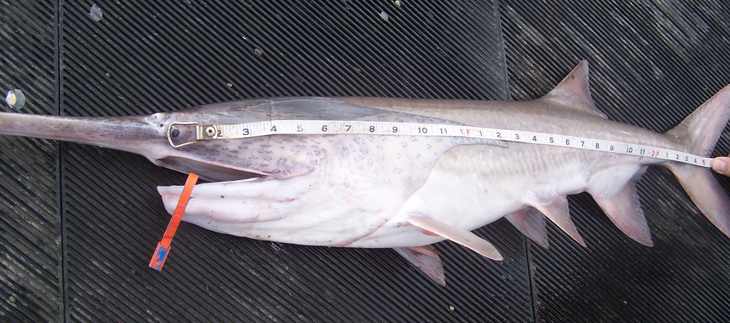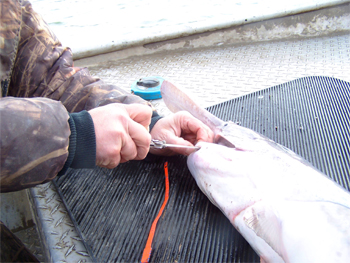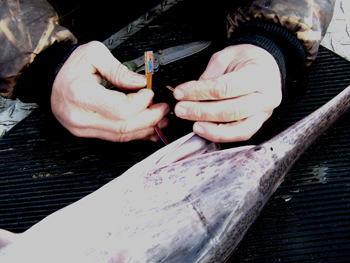Season Dates: Feb. 1 - April 30 sunrise to sunset
This special paddlefish snagging season is limited to waters of the Big Sioux River below the I-29 bridge (both Iowa and South Dakota waters) and Iowa waters only on the Missouri River beginning at the Big Sioux River confluence and extending to the Hamburg Landing boat ramp. This includes all backwaters and sloughs and any tributary of the Missouri River at its confluence and extending below its Interstate 29 bridge.
Download printable maps of the of the Iowa-Nebraska boundary line for Woodbury, Monona, Harrison and Pottawattamie counties. The boundary line in Mills and Fremont Counties is the center of the river channel.
A downloadable GPX file with the boundary line for Iowa waters of the Missouri River is available. Right click and choose "save target as" or "save as", and save the file to your computer (not to your device's card). When saving, change from XML file type to All Files, and type in .gpx at the end of the MissouriRiver_Boundary_Line file name. After saving to your computer, you should be able to add the data to your GPS. The saved file "MissouriRiver_Boundary_Line.gpx" should be universally usable on most GPS units.
Special Paddlefish License and Tag: Licenses are available first come, first served - 950 resident licenses ($25.50) and 50 nonresident licenses ($49) are available each year. You can buy up to two tags per year - one from Dec. 15 to Dec. 31 and an additional tag from Jan. 1 to Jan. 7, or two tags if you didn’t buy one in December.
Buy your license via the Iowa DNR online licenses sales website.
You will receive your paddlefish license and tag(s) in January along with a packet of information that will help you have a successful season. Special License Requirements: A resident angler must have a fishing license plus a special paddlefish license. A nonresident angler must have a fishing license that is valid in Iowa plus a special nonresident paddlefish license. Resident and nonresident youth under sixteen years of age are not required to have a fishing license; however they must have a special paddlefish license. Youth under sixteen years of age must first get an Iowa DNR Custom ID number before buying a special paddlefish license. Customer ID numbers are available from any Iowa DNR license vendor.
You must have a valid paddlefish license and unused tag(s) to fish for paddlefish. You can snag fish to catch paddlefish and rough fish (common carp, bighead carp, silver carp, grass carp, black carp, bigmouth buffalo, smallmouth buffalo, black buffalo, quillback, highfin carpsucker, river carpsucker, spotted sucker, white sucker, shorthead redhorse, golden redhorse, silver redhorse, freshwater drum, shortnose gar, longnose gar, bowfin, gizzard shad and goldfish). Once you have caught and used all of your tags on Paddlefish, you must stop snagging. Hooks and Gaffe: You cannot use hooks larger than 5/0 treble or measuring more than 1¼ inch in length when two of the hook points are placed on a ruler. You cannot use a gaffe hook or other penetrating device to help you land any snagged fish. This is the regulation for Iowa waters. If fishing in the South Dakota waters of the Big Sioux River, you are limited to 2/0 treble hooks (1/2” gap from shank to tip of hook).
 Length Limit:
Length Limit:
You can only possess paddlefish less than 35-inches or more than 45-inches. You must immediately release alive all paddlefish measuring 35-inches to 45-inches when measured from the front of the eye to the natural unaltered fork of the tail. To properly measure a paddlefish, use a flexible tape and measure along and over the center line contour of the fish while it is lying flat.
Measuring a Paddlefish:

Measure from the front of the eye to the fork of the tail. Paddlefish between 35” and 45” must be released.
Tagging, Possessing and Processing Paddlefish: Immediately upon taking into possession a legal paddlefish, you must visibly attach the transportation tag issued with the license to the fish’s lower jaw. Attach the tag in such a way that it cannot be removed without mutilating or destroying the tag. You cannot possess a paddlefish license or transportation tag issued to another angler or tag a paddlefish with a transportation tag issued to another angler. The transportation tag must remain attached to the paddlefish until it is processed for consumption. The paddlefish must remain intact except for the snout in front of the eye until the fish reaches the final processing place. The “final processing place” is defined as your home or the location where consumption occurs. The transportation tag is your proof of possession of the carcass.


Cut slit in jaw for transportation tag. Slide the tag’s tab into slot until locked.
Closed Season: During the closed season, you cannot possess paddlefish on waters opened to paddlefish snagging during the season.
Harvesting Tips
Why Snagging?
Paddlefish are one of the largest freshwater fish in North America. The Iowa state record for a paddlefish is 107 pounds, caught in 1981 on the Missouri River. Paddlefish feed on microscopic organisms called zooplankton. Since they are filter feeders, they cannot be caught effectively with traditional hook-and-line methods; snagging is the only efficient method of take.
Recommended Gear
Use long, heavy action rods with 50 – 100 pound test line. Longer rods let you snag at a slower pace with longer sweeps to cover more water area. Whether you prefer bait casting or spinning reels, make sure the reel is well maintained with functional drag. In Iowa, you must use treble hooks 5/0 or smaller for snagging. Many anglers recommend 2/0 – 5/0 hooks tied 18 – 36 inches above a 2- to 6-ounce weight. Heavier weights are better for casting in fast, deep water. Use lighter weights when fish are closer to the surface or in slow-moving water.
Techniques
Paddlefish prefer slower, deep water. Scout with a depth finder for pockets of deep water, or head to areas slightly downstream from wing dams. Paddlefish feed in the current coming off the end of the dam.
Some anglers prefer to vertically snag for paddlefish from a stationary boat over a deep hole. Another option is to cast into the current seam from shore or an anchored boat. This is very effective in shallower areas where angler activity may frighten fish out of the area.
Safety Precautions
Be safe when heading out on spring waters. Rivers can change over the winter with new downed trees, snags, floating ice and even changing locations of sandbars. Be aware of your surroundings while boating. Make sure your boat motor is running properly after being stored during the winter.
Going overboard into cold water can be dangerous and possibly fatal. Have dry clothes with you. Do not snag from dangerous positions in the boat. Keep a knife or pliers nearby in case you find yourself attached to a large fish by a treble hook or heavy fishing line. Know your own limitations; heavy rods and reels, and a long day of snagging, can prove tiring for people with lower physical strength.